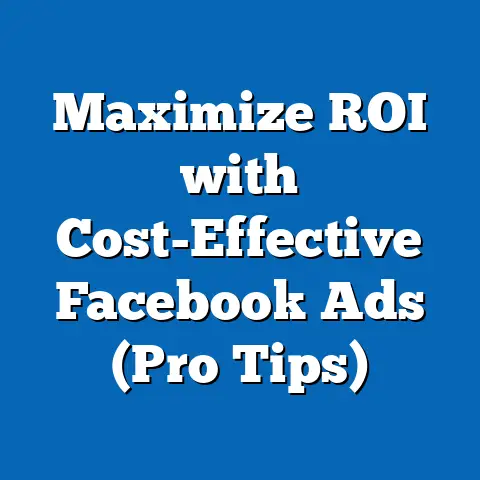Unlock CFO Facebook Ads Success (Strategic Insights Unveiled)
In today’s rapidly evolving business landscape, digital advertising has become an indispensable tool for growth. As a seasoned digital marketing expert, I’ve seen firsthand how savvy Chief Financial Officers (CFOs) are increasingly recognizing the power of platforms like Facebook to drive significant ROI, boost customer engagement, and ultimately, enhance business profitability. For CFOs, who are the strategic financial architects of their organizations, mastering Facebook advertising isn’t just a marketing endeavor; it’s a financial imperative.
I remember working with a mid-sized retail company whose CFO was initially skeptical about investing heavily in Facebook ads. He saw it as a marketing expense, not a strategic investment. However, after implementing a data-driven Facebook ad strategy, we were able to demonstrate a direct correlation between ad spend and increased sales, leading to a 30% boost in revenue within a quarter. This experience highlighted the transformative potential of Facebook ads when approached with a CFO’s analytical mindset.
The insights I’m about to share are “must-have” for any CFO looking to unlock the full potential of Facebook ads. Understanding the intricacies of this platform can transform it from a mere marketing tool into a powerful engine for financial growth. Let’s dive into the strategic insights that will empower you to leverage Facebook ads to achieve remarkable success.
Understanding the Facebook Ads Ecosystem
The Facebook advertising ecosystem can seem overwhelming at first glance, but understanding its key components is crucial for any CFO looking to make informed decisions.
Ad Formats: More Than Just Pictures
Facebook offers a variety of ad formats, each designed to cater to different marketing objectives and target audiences. Here’s a quick overview:
- Photo Ads: Simple yet effective, photo ads are ideal for showcasing products or services with compelling visuals.
- Video Ads: Captivating and engaging, video ads are perfect for storytelling and demonstrating product features.
- Carousel Ads: Allow users to scroll through multiple images or videos, making them great for showcasing a range of products or highlighting different aspects of a single product.
- Slideshow Ads: Combine multiple images or videos into a dynamic slideshow, offering a cost-effective way to create engaging content.
Choosing the right ad format depends on your marketing goals and target audience. For instance, if you’re launching a new product, a video ad might be the most effective way to capture attention and convey its unique features.
Audience Targeting: Precision is Key
One of Facebook’s greatest strengths is its robust audience targeting capabilities. I’ve seen campaigns skyrocket simply by refining the target audience. You can target users based on:
- Demographics: Age, gender, location, education, and more.
- Interests: Hobbies, activities, and topics they’ve shown interest in on Facebook.
- Behaviors: Purchase history, device usage, and other online activities.
- Custom Audiences: Upload your own customer data to target existing customers or create lookalike audiences.
The ability to target specific audiences ensures that your ads are seen by the people most likely to be interested in your products or services, maximizing your ROI.
Facebook Pixel: Tracking and Optimizing
The Facebook Pixel is a small snippet of code that you place on your website to track conversions and optimize ad performance. It allows you to:
- Track Conversions: See which ads are driving the most sales or leads.
- Optimize Ads: Improve your ad targeting and bidding strategies based on real-time data.
- Retarget Website Visitors: Show ads to people who have visited your website but haven’t yet made a purchase.
I’ve witnessed the Facebook Pixel transform campaigns from guessing games into data-driven strategies. It provides invaluable insights into how users interact with your ads and website, allowing you to make informed decisions and improve your ROI.
The Algorithm: Understanding Ad Placements
Facebook’s algorithm determines which ads are shown to which users and in what order. Understanding how the algorithm works can help you optimize your ad campaigns for maximum visibility. Key factors that influence ad placement include:
- Relevance: Ads that are relevant to the user’s interests and behaviors are more likely to be shown.
- Bid Amount: The amount you’re willing to pay for each ad impression or click.
- Ad Quality: High-quality ads with engaging content are rewarded with better placement.
By creating relevant, high-quality ads and strategically bidding, you can improve your ad placement and reach a wider audience.
Takeaway: Understanding the Facebook ads ecosystem is the first step towards unlocking its potential. By mastering ad formats, audience targeting, the Facebook Pixel, and the algorithm, you can lay the foundation for a successful advertising strategy.
Strategic Budgeting for Facebook Ads
For CFOs, budgeting isn’t just about allocating funds; it’s about making strategic investments that drive measurable results. When it comes to Facebook ads, a well-defined budget is essential for maximizing ROI and achieving your financial goals.
Setting Realistic Goals
Before you start allocating your budget, it’s crucial to set realistic goals based on past performance and market research. Consider factors such as:
- Target Audience: How large is your target audience and how likely are they to convert?
- Industry Benchmarks: What are the average conversion rates and costs in your industry?
- Historical Data: What has worked well in the past and what hasn’t?
I’ve found that setting SMART (Specific, Measurable, Achievable, Relevant, Time-bound) goals is an effective way to ensure that your budget is aligned with your business objectives. For example, instead of setting a vague goal like “increase sales,” set a specific goal like “increase online sales by 15% in the next quarter.”
Budget Allocation and A/B Testing
Once you’ve set your goals, it’s time to allocate your budget across different ad campaigns. I recommend allocating a portion of your budget for A/B testing to optimize your ad spend. A/B testing involves creating multiple versions of an ad and testing them against each other to see which performs best.
By A/B testing different ad creatives, targeting options, and bidding strategies, you can identify the most effective approaches and allocate your budget accordingly. This data-driven approach ensures that you’re not wasting money on ads that aren’t performing well.
Tracking ROI Meticulously
Tracking ROI is essential for measuring the success of your Facebook ad campaigns and justifying your investment. Key metrics to track include:
- Return on Ad Spend (ROAS): The amount of revenue generated for every dollar spent on ads.
- Cost Per Acquisition (CPA): The cost of acquiring a new customer through your ad campaigns.
- Customer Lifetime Value (CLTV): The total revenue you expect to generate from a customer over their relationship with your business.
I’ve seen companies significantly improve their ROI by meticulously tracking these metrics and making data-driven adjustments to their ad campaigns. For instance, if you notice that your CPA is too high, you might need to refine your targeting or improve your ad creatives.
Successful Budgeting Strategies: A Real-World Example
I once worked with an e-commerce company that was struggling to generate a positive ROI from their Facebook ad campaigns. After analyzing their data, we discovered that they were targeting too broad of an audience and not tracking their ROI effectively.
We implemented a new budgeting strategy that involved:
- Refining their target audience: Focusing on specific demographics, interests, and behaviors.
- Allocating a portion of their budget for A/B testing: Testing different ad creatives and bidding strategies.
- Tracking their ROI meticulously: Monitoring ROAS, CPA, and CLTV.
As a result, the company saw a 50% increase in their ROAS within three months. This success story highlights the importance of strategic budgeting and data-driven decision-making.
Takeaway: Strategic budgeting is crucial for maximizing the ROI of your Facebook ad campaigns. By setting realistic goals, allocating your budget effectively, and tracking your ROI meticulously, you can ensure that your ad spend is driving measurable results.
Crafting Compelling Ad Content
In the world of Facebook advertising, content is king. No matter how well you target your audience or how strategically you allocate your budget, your ad campaigns will fall flat if your content doesn’t resonate with your target audience.
The Elements of Impactful Ad Content
Impactful ad content is a combination of compelling visuals, persuasive copy, and clear calls-to-action.
- Visuals: High-quality images and videos are essential for capturing attention and conveying your message effectively.
- Copy: Your ad copy should be concise, engaging, and relevant to your target audience.
- Calls-to-Action: A clear call-to-action tells users what you want them to do, whether it’s visiting your website, making a purchase, or signing up for your email list.
I’ve found that ads with strong visuals and compelling copy tend to perform significantly better than ads with generic or uninspired content.
Collaborating with Marketing Teams
CFOs can play a crucial role in collaborating with marketing teams to create ad content that resonates with target audiences. By sharing their financial insights and business objectives, CFOs can help marketing teams develop content that drives measurable results.
I encourage CFOs to actively participate in the creative process and provide feedback on ad concepts and messaging. This collaboration ensures that your ad content is aligned with your overall business strategy and financial goals.
Brands That Excel in Ad Content Creation
There are many brands that have excelled in ad content creation on Facebook. One example is Nike, which consistently creates visually stunning and emotionally resonant ads that capture the spirit of athleticism and inspire people to achieve their goals.
Another example is Dove, which has built a brand around promoting body positivity and self-esteem. Their ads often feature real women of all shapes and sizes, challenging traditional beauty standards and resonating with a wide audience.
These brands demonstrate the power of creating ad content that is authentic, engaging, and aligned with your brand values.
Maintaining Brand Voice and Consistency
Maintaining brand voice and consistency across different ads and campaigns is essential for building brand recognition and trust. Your ads should reflect your brand’s personality, values, and tone of voice.
I recommend developing a brand style guide that outlines your brand’s visual identity, messaging guidelines, and tone of voice. This guide can help ensure that all of your ad content is consistent and aligned with your brand identity.
Takeaway: Crafting compelling ad content is essential for driving engagement and conversions. By focusing on visuals, copy, and calls-to-action, collaborating with marketing teams, and maintaining brand voice and consistency, you can create ads that resonate with your target audience and achieve your marketing goals.
Analyzing and Optimizing Campaign Performance
Analyzing and optimizing campaign performance is an ongoing process that involves monitoring key metrics, identifying areas for improvement, and making data-driven adjustments to your ad campaigns.
Key Metrics for CFOs
As a CFO, there are several key metrics you should focus on when analyzing Facebook ad performance:
- Click-Through Rate (CTR): The percentage of people who see your ad and click on it.
- Cost Per Click (CPC): The cost of each click on your ad.
- Return on Ad Spend (ROAS): The amount of revenue generated for every dollar spent on ads.
- Conversion Rate: The percentage of people who click on your ad and complete a desired action, such as making a purchase or signing up for your email list.
These metrics provide valuable insights into the effectiveness of your ad campaigns and can help you identify areas for improvement.
Regular Performance Reviews
Regular performance reviews are essential for staying on top of your ad campaigns and making timely adjustments. I recommend reviewing your ad performance at least once a week to identify trends, patterns, and areas for improvement.
During your performance reviews, pay close attention to the key metrics mentioned above and look for any significant changes or anomalies. For instance, if you notice that your CTR is declining, you might need to refresh your ad creatives or refine your targeting.
Optimizing Underperforming Ads
If you identify ads that are underperforming, there are several steps you can take to optimize them:
- Adjust Targeting: Refine your targeting options to reach a more relevant audience.
- Tweak Creative Elements: Experiment with different visuals, copy, and calls-to-action.
- Reallocate Budgets: Shift your budget from underperforming ads to ads that are performing well.
I’ve seen companies significantly improve their ad performance by making these adjustments based on data-driven insights.
Success Through Data-Driven Decision-Making
I worked with a subscription box company that was struggling to generate a positive ROI from their Facebook ad campaigns. After conducting a thorough analysis of their ad performance, we discovered that they were targeting the wrong audience and using ineffective ad creatives.
We implemented a new strategy that involved:
- Refining their targeting options: Focusing on specific demographics, interests, and behaviors.
- Creating new ad creatives: Developing visually appealing and engaging ads that resonated with their target audience.
- Monitoring their ad performance closely: Tracking key metrics and making data-driven adjustments to their ad campaigns.
As a result, the company saw a 100% increase in their ROAS within six months. This success story highlights the power of data-driven decision-making and optimization strategies.
Takeaway: Analyzing and optimizing campaign performance is an ongoing process that requires careful monitoring, data-driven decision-making, and a willingness to experiment. By focusing on key metrics, conducting regular performance reviews, and optimizing underperforming ads, you can significantly improve your ROI and achieve your marketing goals.
Future Trends in Facebook Advertising
The world of Facebook advertising is constantly evolving, with new trends and technologies emerging all the time. As a CFO, it’s essential to stay ahead of the curve and be aware of the future trends that could impact your advertising strategies.
The Rise of Video Content
Video content is becoming increasingly popular on Facebook, and I expect this trend to continue in the future. Video ads are more engaging and captivating than traditional image ads, and they offer a unique opportunity to tell your brand’s story and connect with your target audience on an emotional level.
I recommend experimenting with different types of video ads, such as short-form videos, live videos, and 360-degree videos, to see what resonates best with your target audience.
Augmented Reality (AR) Ads
Augmented reality (AR) ads are an emerging trend that allows users to interact with your products in a virtual environment. For instance, a furniture company could create an AR ad that allows users to see how a particular piece of furniture would look in their home before making a purchase.
AR ads offer a unique and engaging way to showcase your products and drive sales. While they are still relatively new, I expect them to become more prevalent in the future as AR technology becomes more accessible.
Personalized Marketing
Personalized marketing involves tailoring your ads and messaging to individual users based on their demographics, interests, and behaviors. This approach can significantly improve your ad performance by making your ads more relevant and engaging.
Facebook offers a variety of tools and features that allow you to personalize your ads, such as custom audiences, dynamic product ads, and personalized recommendations.
Navigating Privacy Laws and User Data Regulations
Changes in privacy laws and user data regulations, such as GDPR and CCPA, are having a significant impact on Facebook advertising strategies. CFOs have a responsibility to ensure that their advertising practices are compliant with these regulations.
I recommend working with your legal team to understand the implications of these regulations and implement policies and procedures to ensure compliance. This includes obtaining user consent for data collection, providing users with the ability to opt out of data tracking, and being transparent about how you use user data.
Takeaway: Staying ahead of the competition requires embracing innovative advertising techniques and tools offered by Facebook. By exploring emerging trends such as video content, augmented reality ads, and personalized marketing, and navigating privacy laws and user data regulations, you can position your business for success in the ever-evolving landscape of digital advertising.
Conclusion
Facebook ads are a powerful tool for financial growth, and by embracing the strategic insights I’ve shared, CFOs can unlock their full potential. From understanding the Facebook ads ecosystem to crafting compelling ad content and analyzing campaign performance, these insights are essential components of a successful digital marketing strategy.
I encourage you to continuously educate yourself on the evolving landscape of digital advertising and invest in resources that can enhance your Facebook ad strategies. With informed decision-making and strategic implementation, you can achieve remarkable success through Facebook advertising and drive significant financial growth for your organization.






